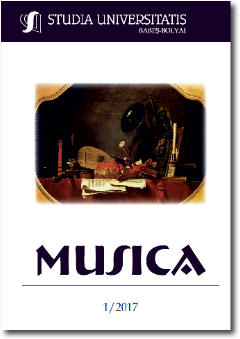THE ROMA MUSICIANS OF MAGYARPALATKA AS PRESERVERS OF TRADITIONS
THE ROMA MUSICIANS OF MAGYARPALATKA AS PRESERVERS OF TRADITIONS
Author(s): Judit Kompár - RőmerSubject(s): Fine Arts / Performing Arts
Published by: Studia Universitatis Babes-Bolyai
Keywords: passing on; Magyarpalatka; gipsy musicians; the profession of musicians; socialisation; self-taught; ethnicity; group; accommodation / adaptation; mediate.
Summary/Abstract: Serving the community through playing music as a role, gradually was filled by gipsy musicians in the Carpathian basin, between the 18th and 20th century. Playing music became a profession and came in hand with a high reputation in society. Through performing music, the gipsy musicians had a tighter contact with the local population as well as they could rise above other ethnic gipsies of the society. Their integration however is not complete. They guard and keep their original native language and operate separately as "gipsy musicians". In the central part of the Great Plain the methods for teaching music were rather different. Most gipsy families passed on their skills and knowledge to the next generation within the family, most of them self-taught, and followed the learning by doing principle. These families’ children were given an instrument into the hand as early as possible, (possibly by the age of 5 or 6) and as soon as they were able to play a few melodies, they followed the bands to different occasions to play alongside them. Following this path, children of musician families learnt the followings at the same time: ability to play an instrument, to be a good chamber musician, correct behaviour in different situations, norm system and their role and place in the community. By the age of 15, they could lead a band (violinists only) on smaller occasion and could earn their living. The fine motor skills used in the instrumental playing can be inherited and also learnt. These skills were integrated on a psychological, biological and social way, into the professional, family and social life of the gipsy musicians. It is very important to mention the learning by hearing self-educating method, as the main used method for learning music and learn to play an instrument. The gipsy musicians used it during their childhood as well as in the later stages of life. This complex way of learning was absolute key factor to their employment and their chance to earn money. The musicians of Magyarpalatka served their own village's musical need as well as most of the surrounding areas too, let there be Hungarians, Rumanians or gipsy communities. The music played in their heads, grouped by ethnicity or personal preference of the villagers. They always knew perfectly well to whom what and how to play or perform. The bands regularly played in several (4 or even 8) villages, therefore the music was somewhat given and taken between different communities. As the musicians were delivering a service to the people, the musicians would never identify themselves with the costumers (the majority of the population around them), but they could get emotionally attached to them through entertaining people by playing their music. Although the musicians were a separate group of people from the common peasants, they had a vital social role in the village life. (The relationship was with each served group mutual.) The gipsy musicians were highly sought after, therefore it was quite natural to pass the profession on to the next generation, for example in Magyarpalatka, we know of 68 professional musicians through five generations! These musicians were extremely popular especially during the 20th century and so a great legacy of them was left in the area for the next generations. (This dynasty was not the only one with such impact; there were many others within the Carpathian basin.) The current generation of this dynasty - due to the globalisation which involves the whole world - has been reduced to the absolute minimum, despite of their ability to accommodate to any circumstances. The profession of musicians went through a transformation of status. Through modernisation, music becomes more and more machine like, due to urbanisation the small villages loose most of their population who cannot employ the local traditional musicians. However the musical material keeps on living in dance houses (ceilidh events), and through performances thanks to the revival movement. This keeps the current traditional musicians employed, reinforces the local culture and identity, it makes the younger generation to study and polish the traditional folk music and dance.
Journal: Studia Universitatis Babes-Bolyai - Musica
- Issue Year: 62/2017
- Issue No: 1
- Page Range: 155-183
- Page Count: 29
- Language: English

